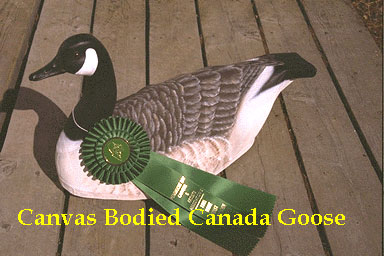
Canvas-bodied decoys reached their zenith during the heyday of the market gunner. It wasn't that wooden bodied decoys weren't available...these could be made less expensively. And it didn't hurt that they were considerably lighter than their counterparts made of wood. That made them ideal for large bird decoying, especially geese.

Market gunners sure didn't paint their deks (for the unitiated, that's pronounced deeks) like this one, but then they were't inclined to enter theirs in competitions either.
This one is made like the originals. The body is formed with a bottom board and wooden backbone with eight 8-gauge wire "ribs". Once the head/neck and a tailboard are added, 10oz. canvas is stretched taut and nailed down with tacks. Actually it's the same stuff we use to recover old canoes and it doesn't stretch any easier here than it does there. Other fabrics stretch easier but aren't nearly as tough.
The next step is to saturate the canvas with oil based house paint...sand and then paint it again. That takes several days to dry, after which the decoy is ready for painting.
It's a time-consuming process, but a gratifying one, especially when the finished decoy turns out to be the judges' Hunter's Choice (Best of all Floaters).
Contact
us for details
Return to DTD Home Page
Duck Trap
Decoys
P.O. Box 88
Lincolnville Beach, ME 04849
phone: 207-789-5363
© Duck Trap Decoys.